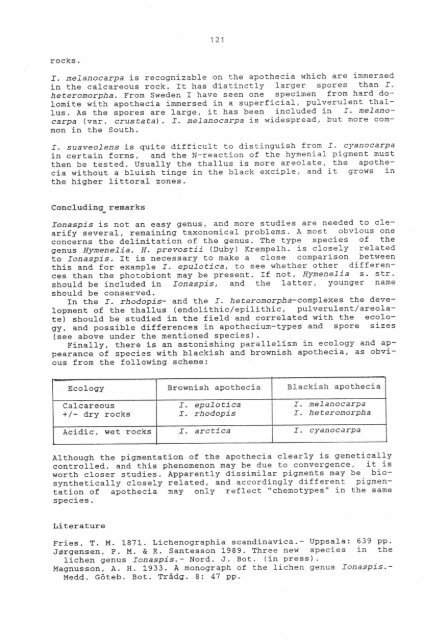Create successful ePaper yourself
Turn your PDF publications into a flip-book with our unique Google optimized e-Paper software.
ocks .<br />
121<br />
I. nelanocarpa is recognizable on the apothecia which are immersed<br />
in the calcareous rock. It, has distinctly larger spores than Iheteromorpha.<br />
From Sweden I have seen one specimen from hard dolomite<br />
wittr apothecia immersed in a superficial, pulverulent thal-<br />
Ius. As the spores are large, it has been included in I. melanoearpa<br />
(var. crustatal . I. melanocarpa is widespread, but more common<br />
in the South.<br />
f . sua veolerzs is quite dif f icult to distinguish f rom I. cyanocarpa<br />
in certain forms, and the N-reaction of the hymenial pigment must<br />
then be tested, Usually the thallus is more areolate, the apothecia<br />
without a bluish tinge in the black exciple, and it grows in<br />
the higher littoral zones.<br />
Concluding remarks<br />
fonaspis is not an easy genus, and more studies are needed to clearify<br />
several, remaining taxonomical problems. A most obvious one<br />
concerns the delimitation of the genus. The type species of the<br />
grenus Hymenelia, H. prevostii (Duby) KrempeIh. is closely related<br />
lo fonaipjs, It is necessa<strong>ry</strong> to make a close comparison between<br />
this and for example f. epuTotica, to see whether other differences<br />
than the pnotobiont may be present. If not , Hymenelia s. str.<br />
should be included in lonaspis, and the lat,ter, Younger name<br />
should be conserved.<br />
In t,he I. rhodopis- and the I. heteromotpha-complexes the development<br />
of the thallus ( endolithic / ep:-lithic, pulverulent / ateolate)<br />
should be studied in the field and correlated with the ecology,<br />
and possible differences in apothecium-types and spore sizes<br />
(see above under the mentioned species) -<br />
Finally, there is an astouishing parallelism in ecology and appearance<br />
of species with blackish and brownish apothecia, os obvious<br />
from the following schene:<br />
Ecology Brownish apothecia Blackish apothecia<br />
Calcareous<br />
+/- d<strong>ry</strong> rocks<br />
I. epuTotica<br />
I. rhodopis<br />
I. melanocarpa<br />
I. heteromorpha<br />
Acidic, wet rocks I. atctica f. cyanocarpa<br />
Although the pigmentation of the apothecia clearly is genetically<br />
controlLed, this phenomenon may be due to convergence, it is<br />
worth closer "nd studies. Apparently dissirnilar pigments may be biosynthetically<br />
closely related, and accordingly dif f erent pigrmentation<br />
of apothecia may only reflect "chemotypes" in the same<br />
species.<br />
Iriterature<br />
Fries , T. M. 1871 . Irichenographia scandinavica . - Uppsala : 639 pp -<br />
J6rgensen. P. M. & R. Santesson 1989. Three new species in the<br />
lichen genus fonaspjs. - Nord. J. Bot. ( in press ) .<br />
Magrnusson, A. H. 1933 . A monograph of the lichen genus Ionaspjs. -<br />
Medd. G6t,eb . Bot . Tr6dg. 8 : 47 PP -

















